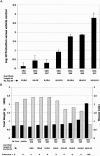Synthetic toll-like receptor 4 agonists stimulate innate resistance to infectious challenge
- PMID: 15845512
- PMCID: PMC1087352
- DOI: 10.1128/IAI.73.5.3044-3052.2005
Synthetic toll-like receptor 4 agonists stimulate innate resistance to infectious challenge
Abstract
A compound family of synthetic lipid A mimetics (termed the aminoalkyl glucosaminide phosphates [AGPs]) was evaluated in murine infectious disease models of protection against challenge with Listeria monocytogenes and influenza virus. For the Listeria model, intravenous administration of AGPs was followed by intravenous bacterial challenge 24 h later. Spleens were harvested 2 days postchallenge for the enumeration of CFU. For the influenza virus model, mice were challenged with virus via the intranasal/intrapulmonary route 48 h after intranasal/intrapulmonary administration of AGPs. The severity of disease was assessed daily for 3 weeks following challenge. Several types of AGPs provided strong protection against influenza virus or Listeria challenge in wild-type mice, but they were inactive in the C3H/HeJ mouse, demonstrating the dependence of the AGPs on toll-like receptor 4 (TLR4) signaling for the protective effect. Structure-activity relationship studies showed that the activation of innate immune effectors by AGPs depends primarily on the lengths of the secondary acyl chains within the three acyl-oxy-acyl residues and also on the nature of the functional group attached to the aglycon component. We conclude that the administration of synthetic TLR4 agonists provides rapid pharmacologic induction of innate resistance to infectious challenge by two different pathogen classes, that this effect is mediated via TLR4, and that structural differences between AGPs can have dramatic effects on agonist activity in vivo.
Figures






Similar articles
-
Immunostimulatory activity of aminoalkyl glucosaminide 4-phosphates (AGPs): induction of protective innate immune responses by RC-524 and RC-529.J Endotoxin Res. 2002;8(6):453-8. doi: 10.1179/096805102125001064. J Endotoxin Res. 2002. PMID: 12697089
-
TLR4 agonists as immunomodulatory agents.J Endotoxin Res. 2006;12(5):313-9. doi: 10.1179/096805106X118753. J Endotoxin Res. 2006. PMID: 17059695
-
Taking a Toll on human disease: Toll-like receptor 4 agonists as vaccine adjuvants and monotherapeutic agents.Expert Opin Biol Ther. 2004 Jul;4(7):1129-38. doi: 10.1517/14712598.4.7.1129. Expert Opin Biol Ther. 2004. PMID: 15268679 Review.
-
FimH, a TLR4 ligand, induces innate antiviral responses in the lung leading to protection against lethal influenza infection in mice.Antiviral Res. 2011 Nov;92(2):346-55. doi: 10.1016/j.antiviral.2011.09.004. Epub 2011 Sep 14. Antiviral Res. 2011. PMID: 21945041
-
Taking toll: lipid A mimetics as adjuvants and immunomodulators.Trends Microbiol. 2002;10(10 Suppl):S32-7. doi: 10.1016/s0966-842x(02)02426-5. Trends Microbiol. 2002. PMID: 12377566 Review.
Cited by
-
TLR Agonists as Mediators of Trained Immunity: Mechanistic Insight and Immunotherapeutic Potential to Combat Infection.Front Immunol. 2021 Feb 18;11:622614. doi: 10.3389/fimmu.2020.622614. eCollection 2020. Front Immunol. 2021. PMID: 33679711 Free PMC article. Review.
-
TLRs in pulmonary diseases.Life Sci. 2019 Sep 15;233:116671. doi: 10.1016/j.lfs.2019.116671. Epub 2019 Jul 20. Life Sci. 2019. PMID: 31336122 Free PMC article. Review.
-
Toll or toll-free adjuvant path toward the optimal vaccine development.J Clin Immunol. 2007 Jul;27(4):363-71. doi: 10.1007/s10875-007-9087-x. Epub 2007 Mar 17. J Clin Immunol. 2007. PMID: 17370119 Review.
-
Pattern Recognition Receptor Signaling and Innate Responses to Influenza A Viruses in the Mallard Duck, Compared to Humans and Chickens.Front Cell Infect Microbiol. 2020 May 12;10:209. doi: 10.3389/fcimb.2020.00209. eCollection 2020. Front Cell Infect Microbiol. 2020. PMID: 32477965 Free PMC article. Review.
-
Co-Delivery of Novel Synthetic TLR4 and TLR7/8 Ligands Adsorbed to Aluminum Salts Promotes Th1-Mediated Immunity against Poorly Immunogenic SARS-CoV-2 RBD.Vaccines (Basel). 2023 Dec 23;12(1):21. doi: 10.3390/vaccines12010021. Vaccines (Basel). 2023. PMID: 38250834 Free PMC article.
References
-
- Akira, S. 2003. Mammalian Toll-like receptors. Curr. Opin. Immunol. 15:5-11. - PubMed
-
- Ayabe, T., D. P. Satchell, C. L. Wilson, W. C. Parks, M. E. Selsted, and A. J. Ouellette. 2000. Secretion of microbicidal alpha-defensins by intestinal Paneth cells in response to bacteria. Nat. Immunol. 1:113-118. - PubMed
-
- Baldridge, J. R., C. W. Cluff, J. T. Evans, M. J. Lacy, J. R. Stephens, V. G. Brookshire, R. Wang, J. R. Ward, Y. M. Yorgensen, D. H. Persing, and D. A. Johnson. 2002. Immunostimulatory activity of aminoalkyl glucosaminide 4-phosphates (AGPs): induction of protective innate immune responses by RC-524 and RC-529. J. Endotoxin Res. 8:453-458. - PubMed
-
- Berger, F. M. 1967. The effect of endotoxin on resistance to infection and disease. Adv. Pharmacol. 5:19-46. - PubMed
Publication types
MeSH terms
Substances
LinkOut - more resources
Full Text Sources
Other Literature Sources
Medical

